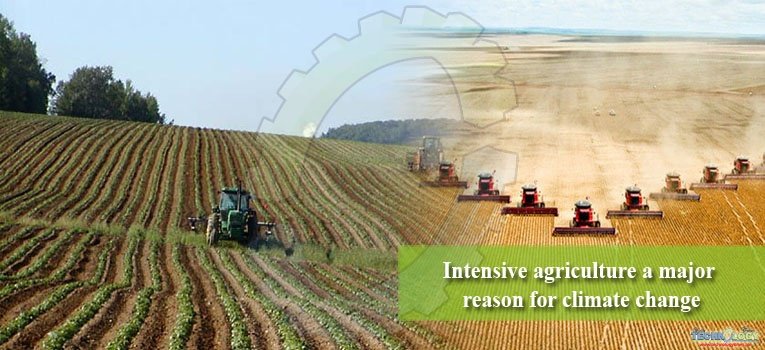Now, climate change is becoming a major issue, not only in Pakistan but in all over the world. There are many reasons of climate change but intensive agriculture is one of the major reasons involving in climate change.

Intensive agriculture means growing of crops continuously, with the use of high quantity of chemicals, without keeping in mind its effects on soil fertility and climate. In past, the population is very low and the people fulfill their bellies by eating and growing of different crops on the small land and by hunting the animals.
As the population increases, the demand for food also increases. With the increase in demand, people began to grow crops with use of high fertilizer, pesticides, herbicides and insecticides rates, without any fallow period in order to fulfill the need of food of increase in population. But they do not keep in mind, the negative impacts of this intensive agriculture.
Our agricultural sector plays very important role in food security but intensive agriculture leads towards production of different gases (methane, carbon dioxide, nitrous oxide) which cause global warming.
No doubt, intensive agriculture production system increases the yield of crops to ensure food security but also leads towards exploitation and degradation of natural resources.
This intensive agriculture causes negative impacts on biodiversity and soil degradation such as depletion of natural resources, soil erosion and climate change. According to studies, about 25 to 30% of global green house gas emission takes place in intensive and industrial agriculture.
There are two different ways i.e. directly and indirectly by which emission of greenhouse gases (GHGs) like nitrous oxide, methane and carbon dioxide takes place in fossil-fuel and heavy chemicals based industrial and intensive agriculture.
Directly, GHG emission takes place during;
- Food processing
- Burning of fuel in farm machinery during different farm practices
- Burning of fuel in the transport system like truck in order to send the harvested crop from farm to the eating table
- Volatilization of nitrogen from soil surface
Indirectly, GHG emission takes place during;
- Preparation of artificial chemicals (pesticides and fertilizers) like nitrogenous fertilizers from natural gas
- Break down of organic matter into carbon dioxide which goes into the atmosphere and causes climate change
- Fermentation of farm yard manure on the animal feed lock
Use of excessive chemical for a long time is a catastrophic for soil health and also for natural environment. Ecological balance in the soil becomes disturbed, organic matter is also slacken off, and soil ability is reduced to hold more soil moisture. Monoculture farming and excessive chemical use increase the changes of pest and disease attack on crop.
Toxic chemicals are either gone towards atmosphere or seep down through soil profile and pollute the water table and can be seen in our food, after cooking as well as during processing. Production of rice on large scale is also a major cause of global warming with respect to methane emission.
In order to increase nitrogen contents in wheat grains, farmers add more nitrogen which is volatized in large quantity, after application and cause global warming. At high temperature, methane gas from the root zone transfer to atmosphere and become the part of greenhouse gasses.
However, according to estimation 3.1*10000000000 tons of carbon biomass is exposed to burning, annually. Greenhouse gasses in the atmosphere trap heat and makes and plant surface warmer. Human activities in agriculture like burning of fossil fuels are the major cause of climate change through greenhouse gasses emission.
According to studies, forestry and other land use contribute about 11% and fossil fuel and industrial processes about 65% in total carbon dioxide gas emission. Some sectors involved in greenhouse gases (GHGs) emission are given in table 1.
Table 1: Annual green house gas emission by different sectors (%)
| Sectors | Annual GHGs emission (%) |
| Industrial processes | 16.8 |
| Burning of fuel during transportation | 14 |
| Agricultural byproducts | 12.5 |
| Livestock | 14 |
| Fossil fuel retrieval, distribution and processing | 11.3 |
| Power stations | 21.3 |
| Waste disposal and treatment | 3.4 |
| Land use and biomass burning | 10 |
| Residential, commercial and other sources | 10.3 |
Hence, intensive agriculture production system is one of the main sources of greenhouse gases emission especially, carbon dioxide in atmosphere which ultimately, causes climate change.
This climate change warms the earth by trapping the more sunlight on the earth’s surface and affects the plant health as well as human health, adversely.
Authors: Tanveer Ahmad*, Rikza Anwar Ul Haq Awan, Ayesha Mustafa, Fareeha Athar, Mohsin Ali and Shoaib Nadeem
*Agro-Climatology Lab, Department of Agronomy, University of Agriculture, Faisalabad